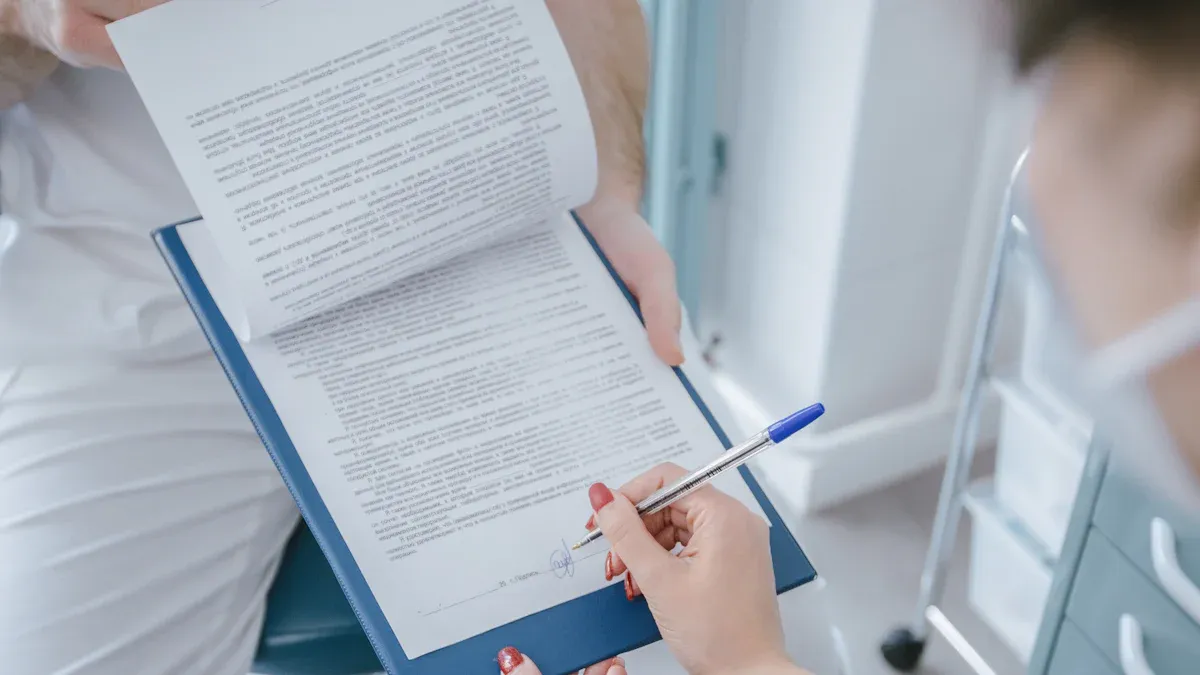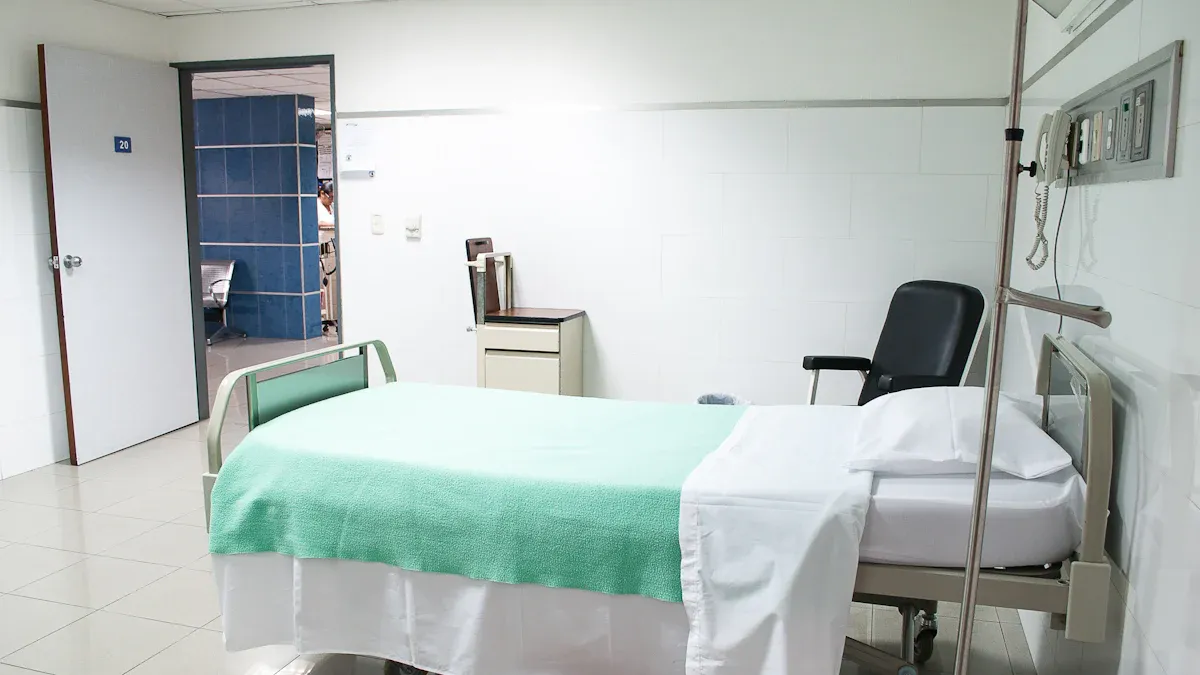Image Source: unsplash
When I think about medical malpractice cases, I see how harmful they are for patients and their families. These cases often happen because of serious problems like:
1. Diagnosing wrong or not diagnosing at all
- Injuries during birth
- Mistakes with treatment or medicine
- Death caused by errors
Most of these cases happen when a doctor or nurse doesn’t do the right thing, like checking test results, or does something wrong, like giving the wrong medicine.
If you’ve been hurt because of carelessness, you deserve fairness. Understanding ‘Medical Malpractice Claims: How to Prove Negligence and Win’ is crucial. To prove negligence in medical malpractice cases, you need to understand the steps and have strong proof to win your case.
Key Takeaways
- Learn the four main parts of medical malpractice: a doctor-patient connection, breaking care rules, showing negligence caused harm, and proving damage. Knowing these steps is key for a good case.
- Collect solid proof like medical records, expert opinions, and witness reports. This evidence is important to back up your claims and show negligence clearly.
- Talk to an experienced medical malpractice lawyer early on. Their knowledge can help you handle legal issues, get fair payment, and defend your rights.
The Four Key Elements of Medical Malpractice

Image Source: pexels
To win a medical malpractice case, you must know four key parts. These parts are the base of your case and help prove negligence.
Proving a Doctor-Patient Relationship
First, you need to show there was a doctor-patient relationship. Without this, the doctor isn’t legally required to care for you. Some cases argue about this, but past rulings make it clear:
- In Hurley v. Eddingfield, the court said doctors must agree to treat patients.
- Ricks v. Budge showed that once a doctor treats you, they must provide care.
- Childs v. Weis explained that no formal relationship means no responsibility.
- Mead v. Adler proved even small advice can create this relationship.
If you can prove this connection, you’ve passed the first step.
Showing a Breach of Care
Next, you must prove the doctor didn’t meet proper care standards. This means they didn’t act like a skilled doctor would in the same situation. Common examples include:
- Diagnosing wrong or too late
- Mistakes during surgery, like operating on the wrong body part
- Giving the wrong medicine
To prove this, you need to show the doctor had a duty, failed it, and caused harm. Experts often explain how the doctor’s actions were not acceptable.
Linking Negligence to Injury
You must connect the doctor’s mistake to your injury. This is often the hardest part to prove. Sometimes, missing records or different expert opinions make it tricky. Strong proof, like medical records and expert help, is needed. Statements from hospital staff can also help. Without this link, your case might fail.
Proving Harm
Lastly, you need to show the mistake caused real harm. This includes money losses, like medical bills or lost pay, and personal suffering, like pain. For pain, methods like the Multiplier Method are used to measure how bad the injury is. Proving harm is key to getting fair payment.
Knowing these four parts helps you build a strong case. If you prove all of them, you can hold careless doctors responsible.
Evidence Needed to Show Negligence
To win your case, proof is very important. Without it, showing negligence is very hard. Here are the main types of proof you’ll need.
Why Medical Records Matter
Medical records are the most important proof in these cases. They show your health before, during, and after treatment. These records include:
- Notes and diagnoses from doctors
- Test results and scans
- Medicines prescribed
Mistakes in these records can hurt your case. Missing or incomplete records might leave out key facts. Errors can make your claim seem less believable. That’s why checking these records closely is so important. If you find mistakes, talk to your lawyer right away.
How Expert Testimony Helps
Experts are very important in proving negligence. They explain what proper care should look like. They also show how the doctor or nurse failed to meet that care. For example, an expert might explain how a wrong diagnosis or surgery mistake broke the rules of good care.
The best experts have high degrees, certifications, and lots of experience. They often work in the same field as the doctor in question. Their knowledge and fairness make their words strong in court.
Experts make hard medical ideas easier for judges and juries. Their help makes sure your case is clear and correct.
Tracking Economic and Non-Economic Losses
It’s also important to keep track of all your losses. Economic losses include medical bills, lost pay, and future care costs. Non-economic losses, like pain and suffering, are harder to measure but still matter. Keeping good records of these losses makes your case stronger and helps you get fair payment.
By collecting strong proof, you can build a solid case. This step is key to holding careless doctors or nurses responsible.
Overcoming Challenges in Medical Malpractice Claims
Meeting the Burden of Proof
Proving negligence in medical malpractice cases can be tough. Many people face three big problems:
- Not Enough Evidence: Without proof, even strong cases can fail.
- Conflicting Evidence: Both sides may have strong arguments, making decisions hard.
- Expert Witnesses: Experts are needed to explain hard medical ideas.
To handle these problems, follow these simple steps:
- Know who must provide the evidence.
- Gather strong proof for every claim.
- Check facts carefully to avoid mistakes.
- Think critically to find hidden details.
- Question everything and ask for solid proof.
These steps can help make your case stronger and meet the proof needed.
Navigating Legal Complexities
Medical malpractice cases can be legally tricky. You must prove a doctor-patient relationship existed. Then, show the doctor’s mistake broke care rules and caused harm. Proving causation is often the hardest part. Pre-existing conditions or other causes can make this step harder.
To handle these legal issues, try these tips:
- Get medical help quickly to record injuries.
- Save all medical records to spot mistakes.
- Write down symptoms and treatments in a journal.
- Talk to a skilled lawyer early to follow legal rules.
These actions can help you avoid mistakes and build a strong case.
Addressing Statute of Limitations
Time is very important in medical malpractice cases. Each state has a time limit, called the statute of limitations. Missing this deadline means losing your chance to get justice. For example:
| State | Time Limit |
|---|---|
| California | 3 years from injury or 1 year after discovery |
| Florida | 2 years |
| New York | 2.5 years |
| Texas | 2 years |
If you miss the deadline, your case will be dismissed. You won’t get any payment. Act fast and talk to a good lawyer to meet deadlines and protect your rights.
By facing these challenges early, you can improve your chances of winning your case.
Steps to Build a Strong Case

Image Source: unsplash
Gathering Important Evidence
To make your case strong, collect the right proof. Focus on these key items:
- Medical Records: These show the care you got and any mistakes.
- Expert Testimony: Experts explain how the doctor or nurse failed.
- Photos and Visual Proof: Pictures of injuries or errors help your case.
- Witness Statements: Nurses or staff can share what went wrong.
- Damage Records: Track money losses and emotional pain.
- Event Timeline: A clear timeline connects all the facts.
Each piece of proof makes your case stronger. The more you gather, the better your chances.
Talking to Medical Experts
Picking the right expert is very important. Look for someone with good skills, knowledge, and experience. Judges check these things to see if they qualify as experts. A good expert explains hard medical ideas in simple ways. This helps the court understand how mistakes happened. Their words can be the key to winning your case.
Keeping Track of Damages
Writing down damages is as important as proving mistakes. Use these tips:
- Journals: Write about your pain, struggles, and daily problems. This shows how the mistake changed your life.
- Photos and Videos: Take pictures of injuries and healing progress. These are strong proof.
- Text Messages: Save messages with doctors or nurses. They may show errors or miscommunication.
These records support your case and help you get fair payment for your losses.
By following these steps, you can create a strong case. This helps hold careless healthcare workers responsible. Good preparation often leads to success in medical malpractice cases.
The Role of a Medical Malpractice Lawyer
Legal Expertise and Guidance
Medical malpractice cases can feel scary and confusing. A good lawyer can make things easier. They have years of experience with these tough cases. Lawyers understand tricky medical words and legal rules that confuse most people. Their knowledge helps them focus on every part of your case.
These lawyers work with important resources, like expert witnesses, to make your case stronger. They plan carefully and adjust to any challenges in your case. This smart guidance helps you avoid mistakes and keeps your case moving forward.
A lawyer’s skills and connections help you face tough legal fights.
Maximizing Compensation
Everyone deserves fair payment for their pain and losses. A medical malpractice lawyer works hard to get that for you. They gather strong proof, like medical records and expert opinions, to support your claim.
Lawyers also stop you from settling too early for less money. Some people take small offers because they don’t know their claim’s real worth. A skilled lawyer fights for the highest payment possible.
With a good lawyer, you can focus on getting better while they fight for fairness.
Advocating for Your Rights
Your rights are important, and a lawyer makes sure they’re protected. Lawyers stand up for people who feel powerless against big hospitals or insurance companies. They speak for you and explain your case clearly in court.
A lawyer doesn’t just represent you—they give you strength. They guide you through every step, from filing papers to showing proof. Their hard work ensures your story is heard and justice is served.
With a lawyer, you’re not just a victim—you’re standing up for what’s right.
Showing negligence in medical malpractice cases needs work, but it matters. Knowing the steps and collecting good proof can help a lot. An experienced lawyer can help you through each part. Act now to defend your rights and seek fairness.
FAQ
What should I do if I think there’s medical malpractice?
Act fast. Collect all your medical records and write down injuries. Talk to a lawyer soon because there are time limits.
How much money can I get?
It depends on your situation. Things like medical bills, lost pay, and pain matter. A lawyer can guess your claim’s worth and help you get fair money.
Can I afford a medical malpractice lawyer?
Yes! Most lawyers only get paid if you win. You don’t pay anything upfront, so anyone can get legal help.
